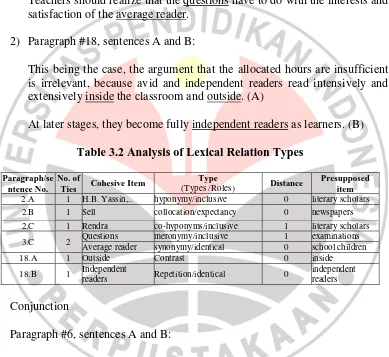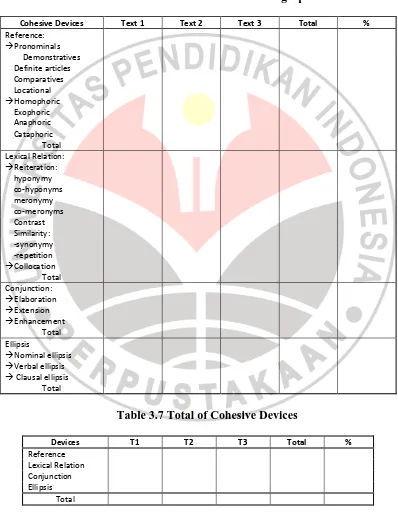27
CHAPTER III
RESEARCH METHODS
This chapter discusses the methods of the research. The sketch of methods is used as guidance in conducting the research and getting intended data. There are four major sections in this chapter; they are statements of the problems, research design, data collection that consists of data resources and procedures of data collection, and the data analysis.
3.1 Statement of the Problems
The problems of the present study are formulated in the following questions:
a. What cohesive devices are employed within paragraphs of the articles of Alwasilah?
b. What cohesive devices are employed inter-paragraphs of the articles of Alwasilah?
c. What is the impact of the use of the devices on cohesiveness of the articles of Alwasilah?
3.2 Design of Research
28
design which yields qualitative data and provides an interpretive analysis of that data since the aim of the study is to identify the cohesive devices of opinion articles which correlate strongly with the cohesiveness of the texts. So, this study is required to describe and interpret what conditions that exist, processes that are going on, or trends that are developing to produce a ‘rich’ and ‘deep’ data.
The instrument of this study is the researcher who does not start the study with a hypothesis and emphasizes the study on the “process” rather than “output”. This is in line with what Meleong says in his book (1989:7). He mentioned that qualitative research is a kind of research that emphasizes on the “process” as the relation of each part or entry which is being examined in a process.
3.3 Data Collection
This section presents two subsections that are related to the data of the study. The first subsection describes the resources of the data that are analyzed in this study, and the delimitation of the data. The second subsection presents the procedures that are used in collecting the data.
3.3.1Data Resources
The main data of the study are the articles written by Alwasilah, which were published in the Jakarta Post and were collectively reprinted in an anthology
29
3.3.2Procedures of Data Collection
To delimit this study, the samples are selected with purposive sampling. There are only three out of thirty-six articles were chosen for this study, as stated by McMillan (2001) that from small samples, purposeful sampling is done to increase the utility of information obtained.
Those articles were appointed based on the year of the publishing in which the articles of the anthology was published during 1997-2000. This sampling process is to simplify the analysis of the writer’s consistency throughout his texts that constitute a strong cohesive.
. The articles of each year were appointed from the anthology that was published during 1997-2000. The chosen texts are “Resurrecting Literature in Schools” (January 22, 1998) that is then labelled as Text #1, “Lament for Minor Languages” (December 13, 1997) as Text #2, and “Ways to Better RI English Skills” (January 18, 1999) as Text #3.
3.4 Data Analysis Methods
30
Underlining all related grammatical and lexical items of each text that meet the criteria of cohesive devices on the text. They are reference, lexical relation, conjunction, and ellipsis and substitution. For examples:
1) Reference:
The pleasures that drawour children first to literature are not those written by Rendra, Sutardji Calzoum Bachri, Goenawan Muhamad, Saini KM and others (Alwasilah 1998).
The pronoun ‘our’ in the sentence does not refer to anything in the text. ‘Our’ refers to something outside the text (the readers and the writer). It is called exophoric reference.
2) Lexical Relation:
Many educators and words-smiths in particular, claim that the present teaching of Bahasa, including literature is a far cry from the ideal. The allocated hours for the subject are not sufficient for teaching the language, let alone for developing literature appreciation (Alwasilah 1998).
In these sentences, ‘literature’ was repeated twice. This word is called lexical reiteration, which involves the repetition of a lexical item. This belongs to repetition.
3) Conjunction:
Tolerance, mutual respect understanding, caring, responsibility, and cooperation are virtues offered by literature (Alwasilah 1998).
‘And’ is called additive conjunction because it adds ‘cooperation’ as virtues offered by literature.
4) Ellipsis:
I don’t know how to work this computer. I’ll have to learn how [Ø].
31 5) Substitution:
Peter takes two weeks’ vacation and Tina does too.
‘Does’ substitutes ‘takes two weeks’ vacation. It is called Verbal Substitution. Listing the classified data separately into tables, reference and lexical relation are firstly put in chain shapes before in the tables, as exemplified in the sentences below that were taken from Text #1 (Alwasilah 1998) :
• Reference:
1) Paragraph #1, sentence A:
The pleasures that draw our children first to literature are not those written by Rendra, Sutardji Calzoum Bachri,. Goenawan Muhamad, Saini KM and others.
2) Paragraph #6, sentence A:
Ours now is the era of modernization and industrialization, which in many cases have polluted established traditions and values.
3) Paragraph #8, sentence A:
Almost all over the globe, educators see literature as part of the humanities.
Table 3.1 Analysis of Reference Types
Paragraph/Se
(Types of reference expression/ roles/types of phora)
that... Definite article/…/cataphoric 0
that draw our children…
Our children Pronominal/plural/exophoric 0 our writer & reader
Those Demonstrative/far/cataphoric 0 those written by…
Others Comparative/difference/anaphoric 0 others authors
6.A 1 Now Locational/…/exophoric -
8.A. 1 The globe Definite article/…/homophoric 0
• Lexical Relation
32
Most children will not become professional literary scholars like H.B. Yassin and the late St. Takdir Alisjahbana.
When they finish school, they are more likely to drive cabs, wait on tables, sell news-papers, to work in stores or factories, and so on and so forth. To assume that they are interested in the works of Rendra, for example, is, in Probst's words (1988), "to make a rash leap of faith".
Teachers should realize that the questions have to do with the interests and satisfaction of the average reader.
2) Paragraph #18, sentences A and B:
This being the case, the argument that the allocated hours are insufficient is irrelevant, because avid and independent readers read intensively and extensively inside the classroom and outside. (A)
At later stages, they become fully independent readers as learners. (B)
Table 3.2 Analysis of Lexical Relation Types
Paragraph/se ntence No.
No. of
Ties Cohesive Item
Type
(Types /Roles) Distance
Presupposed item 2.A 1 H.B. Yassin,.. hyponymy/inclusive 0 literary scholars 2.B 1 Sell collocation/expectancy 0 newspapers 2.C 1 Rendra co-hyponyms/inclusive 1 literary scholars
3.C 2 Questions meronymy/inclusive 1 examinations Average reader synonymy/identical 0 school children
18.A 1 Outside Contrast 0 inside
18.B 1 Independent
readers Repetition/identical 0
independent readers
• Conjunction
Paragraph #6, sentences A and B:
Ours now is the era of modernization and industrialization, which in many cases have polluted established traditions and values.
33
Table 3.3 Analysis of Conjunction Types
Paragraph/s
now explicit enhancing/temporal/simult./ internal 0 in many
cases
explicit
elaborating/clarifying/dismissal/internal 0 6.b. 1 and explicit extending/additive/positive/external 0
• Ellipsis
1) Paragraph #10:
As reported by The Jakarta Post (Jan. 6, 1997), realizing that writers have the power to inform the public, the governor said: "I think you have to make easy-reading and touching stories so people—at all levels—can understand them."
2) Paragraph #15, sentence A:
First, literature is experience, not information.
Table 3.4 Analysis of Ellipsis Types
Paragraph/s entence No.
No. of Ties
Cohesive Item Type Distance Presupposed item
10 1 as [Ø]repoted by Jakarta Post… verbal ellipsis 0 as (preceding texts has)reported by…
15.a. 1 first [Ø],… Nominal ellipsis 0 first (paradigm),…
1) This last sample was taken from text #3, sentence B of paragraph #1: Mixed in are teachers, student motivation, textbooks, bureaucrats' attitude, and government policy.
Table 3.5 Analysis of Ellipsis Types
Paragraph/s entence No.
No. of Ties
Cohesive Item Type Distan
ce Presupposed item
1.b 1 Mixed in [Ø] are teachers, student… clausal ellipsis 0 Mixed in (many variables) are teachers, …
34
counting the frequency and the percentage of the fulfillment of cohesive devices within and inter paragraphs, and assembling the data into tables as the examples below:
Table 3.6 Cohesive Devices within Paragraphs
Cohesive Devices Text 1 Text 2 Text 3 Total %
Table 3.7 Total of Cohesive Devices
35
The last is recapitulating the results of data of each text based on the connection of grammatical and lexical cohesive devices to analyze level of the cohesiveness. Listing the results on a table, as follows:
Table 3.8 Analysis of Level of Cohesiveness
Text #1 Text #2 Text #3
1. Grammatical cohesive devices 2. Frequency of 1 per clause 3. Percentage of 1 entering in chains 4. Explicit lexical tokens
5. Cohesively interpreted lexical tokens 6. Total lexical tokens
7. 5 as percentage of 6
8. Percentage of 1 interpreted anaphorically 9. Percentage of 1 interpreted exophorically 10. Percentage of 1 interpreted ambigious
Interpreting the result of analysis based on the connection of grammatical and lexical cohesive devices. If the number of anaphoric references is more than the exophoric references, the articles are considered to be more cohesive, and vice versa.
3.5 Concluding Remarks



